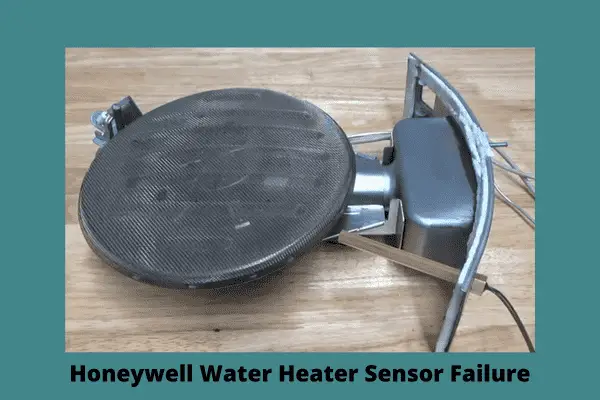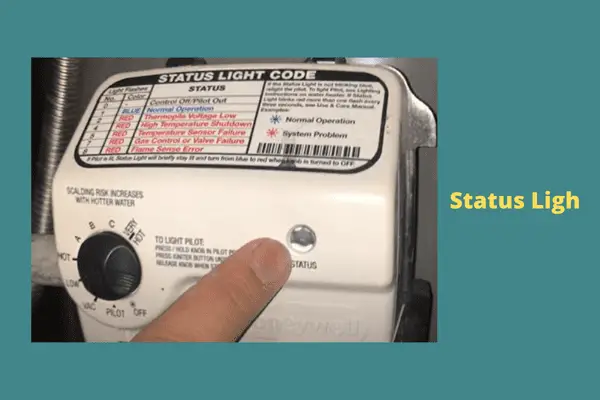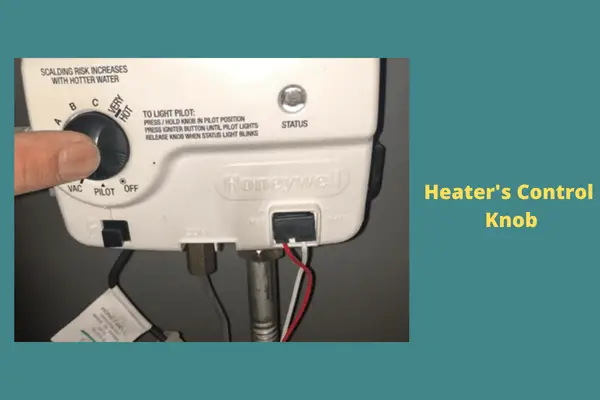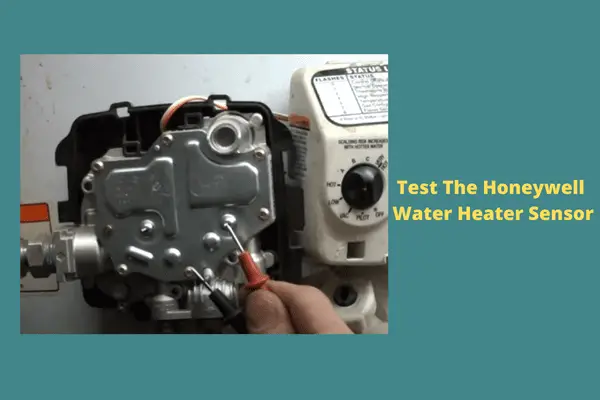The reasons behind your Honeywell water heater sensor failure are:
- A dirty or defective sensor.
- The sensor’s loose connection.
- The sediment accumulation in the sensor.
However, in today’s guide, we will tell you how you can fix the above-mentioned issues and find your Honeywell water heater sensor is working fine.

Quick Solution:
In the first place, power cycle your heater and clean your water heater sensor when you find it fails to work. If these both efforts won’t work, then go on reading the complete guide.
In that way, knowing how the water heater sensor and thermocouple work will help you to troubleshoot the heater sensor issues.
Table Of Contents
- Quick Solution:
- How Does A Water Heater Sensor Work
- What Is A Sensor Failure On A Hot Water Heater
- Functions Of Thermocouple In Water Heater
- How Do You Know Your Honeywell Water Heater Temperature Sensor Is Going Out
- Honeywell Water Heater Sensor Failure [5 Easy Fixes]
- 01. Dirty Sensor
- How To Power Cycle Honeywell Water Heater?
- 02. Faulty Sensor
- How To Test Your Honeywell Water Heater Sensor?
- How To Replace Honeywell Water Heater Temperature Sensor?
- 03. Loose Connection
- 04. Sediment Accumulation
- What To Do If Replacing The Sensor Doesn’t Work
- How To Improve Water Heater’s Efficiency
- FAQ:
- What would cause a water heater reset button to trip?
- Can a water heater work without a thermocouple?
- What is the most common thermocouple failure mode?
- Final Words
How Does A Water Heater Sensor Work
When the temperature sensor detects the drop in temperature, it sends the signal to the tank’s inside heating element.
And then the heating element heats the water. The thermostat cuts off the heating element’s power when your heater reaches the anticipated temperature.
What Is A Sensor Failure On A Hot Water Heater
The Honeywell water heater sensor controls your heater’s heating function. However, your heater’s sensor failure means water is not heating to the perfect temperature.
More specifically, your water heater’s signal switch is a temperature sensor. When it gets damaged, your heater produces too cold or too hot water. Simply, the temperature sensor in your water heater works as a gas control valve signal switch.
Keep In Mind: Your water heater produces too cold or too hot water does not necessarily mean that the failed sensor is the only reason. Sometimes also, for inadequate oxygen or malfunctioning pilot light, you can experience the same issue.
Again, replacing the gas control valve or thermostat gives the signal that your water heater sensor can fail.
Note: You can also read how to fix the Honeywell Water heater status light blinking 3 times.
Functions Of Thermocouple In Water Heater
The thermocouple is a temperature-measuring sensor that controls your water heater’s temperature function. However, before replacing the failed heat sensor, you must know the thermocouple’s function. Those are:
- On your heater’s pilot light tandem, the thermocouples functions
- Your heater’s gas valve remains open due to the thermocouple.
- When the pilot light abruptly keeps going out, the thermocouple turns off the gas supply.
- The malfunctioning thermocouple fails to control the gas supply and can’t observe whether the pilot light is off or on.
Now, before deciding whether your heater’s sensor is bad or not, we recommend you inspect the sensor.
Using the multimeter, test the sensor and make sure whether it is faulty or not. After testing, take the replacement decision.
How Do You Know Your Honeywell Water Heater Temperature Sensor Is Going Out
Whether your water heater sensor is going to fail or not, you will learn it by observing or checking the temperature.

Anyway, your heater’s malfunctioning sensor will give you the following warning before going out.
01. Five Flashes
Due to the defective sensor, your heater’s status light will blink 5 times. Therefore, the blinking light gives you the sensor’s fault indication.
02. Too Hot Water
When your water heater’s temperature rises to unsafe levels, be sure that the failed heat sensor is causing it. Again the damaged sensor causes your heater to overheat.
03. Water Heater Supply Cold Water:
During the hot water running through the pipe, your heater’s temperatures will generally rise.
But in case of a failed sensor, your heater will supply cold or lukewarm water. Or even if your heater provides hot water, it will not last long.
04. Malfunctioning Gas Control Valve
The water heater sensor and gas control valve is highly interdependent. The gas valve fails to receive a signal from the lousy sensor.
As a result, the valve can’t function properly. Thus your water heater can’t heat the water at the desired temperature due to a bad valve.
o5. Thermostat Replacement
Replacing your heater’s thermostat is another signal that your heater’s sensor has become bad.
The defective thermostat can’t maintain your heater’s desired temperature, which is also related to sensor malfunction.
Honeywell Water Heater Sensor Failure [5 Easy Fixes]
Your Honeywell heater’s sensor failure is a serious problem, and several major factors are responsible for it. Those causes and their resolving ways are.
01. Dirty Sensor
The accumulation of dirt and debris in your Honeywell water heater sensor is responsible for its malfunction. When you don’t clean your water heater sensor for a long time or don’t maintain the cleaning routine, it becomes dirty over time with continuous usage.
Solution:
The easy way to fix this hitch is to locate the sensor and clean it. After cleaning the sensor correctly, power cycle your heater.
How To Power Cycle Honeywell Water Heater?
Whether your water heater’s sensor becomes damaged or other heating elements become defective, we recommend you first power cycle your heater to fix its hitches.

If your heater goes through minor problems, conducting a power cycle will help it to function normally again. Now, follow the easy power cycle steps below:
Step 1: First off, start by turning off your heater’s gas control knob. Now pull off your water heater’s outer door. Keep your heater in the pull-off position for 5-10 minutes. All the accumulated gas in your heater will move out within this time.
Step 2: Relight your heater’s pilot after completing the waiting time. Turn your heater’s control knob in the “Pilot” position.
Now the simple task is all the way, push your heater’s knob button. And simultaneously press your heater’s Piezo igniter button.
Step 3: Keep pressing these buttons together until you don’t hear the loud clock sound. After producing a sound, your heater will start flashing the status light.
So, the blinking light means your heater’s pilot is lighting now. Finally, you must set the knob where you prefer to.
Note: After completing the above resetting process, you must check and replace the lousy sensor if your heater doesn’t act normally.
02. Faulty Sensor
So, another big reason why your heater’s temperature fails is the sensor itself is defective.
Going out-of-resistance through the sensor can be the potential reason for its malfunction. Simply due to incorrect resistance, your heater’s sensor can go out and stop working.
Solution:
Firstly test your water heater sensor and measure its resistance. If the resistance goes out of range or the device becomes malfunctioning, you must replace it immediately.
How To Test Your Honeywell Water Heater Sensor?
Using a multimeter, you can test your heater’s sensor. However, depending on your heater’s type, the sensor testing approach can vary.

For testing the temperature sensor, you require to access it first. Anyway, the simple testing steps are as follows:
Step 1: Get your heater’s sensor first by disassembling the gas valve. Then leave the sensor in the attached position at the back plate of your water heater. Now grab a millimeter and set the measurement at Ohms.
Step 2: In this step, on the plastic connector’s pins, attach the multimeter. Use the pin probes to connect it. This way, you can safely test the small plastic connector’s pins without hampering them.
Then on the center hole, insert 1 pin probe and to the outside hole, connect the other probe.
Step 3: It’s time to read the resistance and measure the temperature of your heater’s water. We recommend you take the chart of your heater’s manufacturer. Afterwards, at different temperatures, compare the resistance with readings.
Step 4: Your water heater sensor is perfectly okay if the resistance reading is similar to the chart. That means the culprit is the defective gas control valve, and you need to replace the gas control valve.
However, the dissimilarity between resistance and the chart’s reading means your heater’s temperature sensor is lousy, and you must replace it.
How To Replace Honeywell Water Heater Temperature Sensor?
When your heater’s sensor is dead, you have no option but to replace it. To replace the sensor, you require specific tools, and those are:
- T20 Torx
- 11/32 socket/nut driver
- ½ inch wrench
- ¾ inch wrench
- 3/8 inch wrench
- 7/16 inch wrench
Now efficiently replace your water heater sensor following the steps below:
Step 1: First, disconnect your heater’s gas connection by turning off the gas shut-off valve. Now detach the thermopile and from the gas valve, remove the igniter. Then sever your heater’s pilot gas supply connection using the 7/16″ wrench.
Step 2: Using the ¾ “wrench, cut off your heater’s main gas supply. Afterward, remove your heater’s front door by eliminating the door’s two attached screws. Also, unscrew the 2 screws using the T20 Torx.
Step 3: In this step, use the nut driver to remove the attached nut. Then pull out the burner assembly by removing its screws.
Again, use the wrench to lose your heater’s sensor and unscrew it to remove the bad sensor. Move forward, and install the new sensor and replace the old one.
Step 4: For installing the new sensor, first at the front place, we recommend you put its head. And onto the sensor, connect the hex rod.
Now at the correct place, ensure your sensor’s secure and tight connection. Then reversely follow all the above steps again to reassemble your heater completely.
Note: After completing the above steps, you will successfully replace your heater’s malfunctioning temperature sensor. Still, if the hitch exists or you fail to replace the sensor, it’s better to contact the professionals.
03. Loose Connection
Your heater sensor’s loose connection is also responsible for its malfunction. Due to the loose connection, your water heater sensor fails to signal correctly to the gas control valve.
As a result, your heater fails to warm the water at your required temperature.
Solution:
First off, check your water heater sensor’s connection. In case it is loose, tighten the connection. Also, make sure the sensor perfectly signals your heater gas control valve.
04. Sediment Accumulation
Sediment-like calcium carbonate accumulates on the bottom of your water tank. Sediment accumulation makes the sensor defective as it displaces water and reduces the hot water amount.
Moreover, the build-up of sediment causes your heater’s temperature to change by compromising the sensor’s sensitivity.
Solution:
Properly clean and remove your hot water heater and the sensor’s accumulated sediment. Afterwards, ensure your heater is running well without making any noise.
What To Do If Replacing The Sensor Doesn’t Work
After replacing your heater’s malfunctioning temperature sensor, we recommend you check other faulty components. However, the other steps that you can take to fix the water temperature problem are:
- Take off your Honeywell heater’s burner assembly and clean the dirty burners. Remove the burner’s soot, dirt, or debris and replace the bad burner.
- Inspect the water tank and remove the tank’s accumulated deposit or sediment.
- Check your home’s piping and make sure no pipe is clogged.
How To Improve Water Heater’s Efficiency
You can extend your heater’s temperature sensor life by improving your Honeywell water heater’s operating efficiency.
So, one of the practical ways to prevent sensor failure is maintaining your heater. The simple maintenance tips are:
- Insulate your water heater to reduce 25% – 45% standby heat losses. Again insulate your heater’s hot water pipes to ensure 2°F – 4°F more scalding water.
- Wash out your water tank’s sediment by draining the tank
- Check the T (Temperature) & P(Pressure) relief valves to avoid your heater and sensor’s potential explosion.
- Inspect the anode rode and prevent its rusting
FAQ:
What would cause a water heater reset button to trip?
Your water heater’s reset button can trip due to faulty thermostats, defective heating elements, lousy wiring, ECO malfunction, etc.
Can a water heater work without a thermocouple?
Modern water heater models don’t use thermocouples. Instead, they use the mercury sensor to turn off your heater’s gas valve. So, without a thermocouple, a water heater can work.
What is the most common thermocouple failure mode?
Thermocouple burnout is the most common failure mode. Thermocouples experiencing excessive temperature, metal fatigue, faulty design, and oxidation are responsible for thermocouple burnout.
Final Words
Now you know all the culprits behind your Honeywell water heater sensor failure and how to fix them. So, whenever, you face such sensir failure issue, simply follow our guide and fix it in no time.
However, if you have any queries, ask in the comment section, and we will answer shortly.
